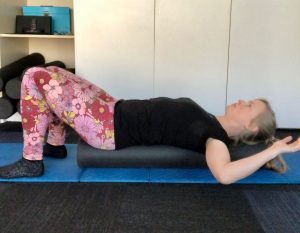Biking Injuries
 As physiotherapists working in a population full of outdoor sport enthusiasts, we are exposed to a wide range of biking injuries! Injuries can be traumatic accidents or chronic injuries that manifest gradually over time and typically arise from an error in technique, training, or equipment. We can certainly take simple measures to prevent chronic ones.
As physiotherapists working in a population full of outdoor sport enthusiasts, we are exposed to a wide range of biking injuries! Injuries can be traumatic accidents or chronic injuries that manifest gradually over time and typically arise from an error in technique, training, or equipment. We can certainly take simple measures to prevent chronic ones.
Let’s understand the most common preventable biking injuries in cyclists and mountain bikers, accompanied by your new essential off-bike prehabilitation toolbox. Cycling season is coming up!
Inadequate ‘cross-training’ or off-bike conditioning is the most common contributor to preventable injuries. Cross-training, or off-bike conditioning aims to restore this balance while ensuring that we are recruiting the best-suited muscles for the job.
Problem #1:
Our position on a bike looks a lot like our position at a desk. Collectively we spend far too much time sitting, develop tight hip flexors and dominant quadriceps along with weak, under-active gluts. This imbalance commonly contributes to patellafemoral pain syndrome (knee pain).
Thankfully we are well informed that a favourable work-station set-up can improve posture and thus, alleviate pain. Similarly, an optimal bike fit and position can play a huge role in alleviating knee pain, among other sources of pain. If you’re doing any pedalling at all, ask your Physio or local bike shop to consider your riding position.
Problem #2:
Our core muscles serve to maintain dynamic control and alignment of our spine and pelvis while riding. The seat being too high or too low may cause pelvic rocking. Excluding this, insufficient core function and endurance can commonly lead to lower back pain. When we descend our core aids in shock absorption, protecting our spine, but also optimizes power output while we pedal. If this system crumbles our hip flexors and back extensors are burdened with a task they weren’t designed for, creating tension-type lower back pain, followed by other secondary injuries if left unaddressed.
Problem #3:
Another common complaint stemming from the positional demands of riding is upper back and neck pain. Considering your bike position, this can be due to inappropriate bar width, seat height and/or reach. Excluding improper bike fit as the source of your pain, this is typically associated with a lack of thoracic spine (mid-upper back) mobility and insufficient shoulder blade and core stability.
While descending if these muscles are slacking, your body is clever to recruit other muscles, namely your pecs, upper trapezius, and neck extensors, to assist in absorbing impact. Similarly, if you’re lacking adequate hip, pelvis and spinal mobility to achieve and maintain a neutral spine while pedalling you will experience fatigue-related discomfort of these same muscles as they attempt to compensate, outside their line of duty.
Time to address these issues…
Over time, if not addressed with appropriate off-bike interventions, these muscular imbalances, and their resultant pain will become reinforced.
To help understand this concept, think of the repercussions we might observe if we asked our doctor to build our house, or a builder to look after your medical health…both would lack the endurance and skill set to excel at the untrained task.
So, while cross-training can’t prevent you from biking injuries such as going over your bars and breaking you clavicle, it can prevent the nagging injuries that creep up on you. Albeit, cross-training can also reduce the severity of your crash-related injuries; strength training increases bone strength; therefore decreasing the likelihood of a fracture. Stability training improves your muscles’ ability to protect your joints and ligaments during a crash, reducing your likelihood of sustaining a ligamentous injury (eg. AC joint). Regardless of your injury severity, off-bike conditioning can shorten your healing timeline and get you back on your bike quicker!
Essential off-bike exercise toolbox to prevent biking injuries…
Stretches
Side lying quad stretch.
Hold onto your foot. Squeeze your bottom so your hips are forward and spine is in neutral. Pull your foot as close to your bottom as you can without arching your lower back. Hold 1 min/ side.
Foam Roll Quads
Pec Stretch
Lie with spine length-wise on a long foam roll or rolled yoga mat. Relax arms out to side as shown trying to keep mid back flat. 2-3 minutes.
Thoracic Mobility
Strengthening
Toe taps
This exercise is a great place to start a core routine, as it aims to wake up and retrain your deep core muscles to stabilise your spine and pelvis. Their competence can, in turn, inhibit overworking back extensors, hip flexors, and muscles of your neck that may be helping absorb impact and stabilise unnecessarily. What is neutral spine?? Keeping the natural curvature in your spine throughout the exercise. What we do in Pilates. Do 2-3 sets of the maximum number of reps you can do correctly.
Superman/ Bird dog
Another great option to challenge your ability to maintain a neutral spine while also challenging shoulder stability in a weight bearing (mountain bike-specific) position.
Exercise 1: Do 2-3 sets of 10-12/side.
Progression 1: Advance by hovering both knees 1cm off the ground and hold 15 secs
Progression 2: From your knee hover position, reach one arm forward and extend your opposite leg behind you, without losing your neutral spine. Do 2-3 sets of 6-12 reps/side (# of reps you are able to do with correct form)!
Plank/Downward dog
Targets core and shoulder stability, as well as providing a dynamic hamstring stretch. Note, this exercise requires adequate thoracic/upper back and shoulder mobility. Consult with your Physio before giving this one a try if you have any current shoulder pain, a history of shoulder impingement or rotator cuff injury/surgery! Try 2-3 sets of 10-12 reps.
Lunges
A list of reasons why these are my personal favourite cross-training and rehabilitation tool for cyclists:
- An effective tool in identifying and correcting dynamic hip, knee and ankle alignment, or tracking errors that can contribute to chronic pain on and off the bike.
- Provides a dynamic hip flexor/quadricep stretch for the back leg.
- They challenge your core and pelvic stability in a way that translates to better power output and glute recruitment on the bike
Your objective is to maintain a level pelvis and neutral spine throughout this exercise. Both knees aiming to reach right angles, think about going down rather than forwards, drive up through the front heel.
Exercise 1: Aim to do the basic version well for 2-3 sets of 15-20 reps targeting endurance
Progression 1: More dynamic as videoed, reverse lunge into high knee.
Progression 2: Add weights in each hand.
In Summary
There you have your Prehabilitation Toolbox to help you prevent biking injuries! All can be done from home with minimal equipment and minimal time, allowing you to spend more time on the trails! I would suggest doing this 3 x week. If you’re looking for additional guidance on personalising your plan or, if you are experiencing pain or limitations with any of the above suggestions, contact us and come in for an assessment.
Happy riding!


